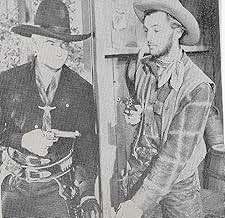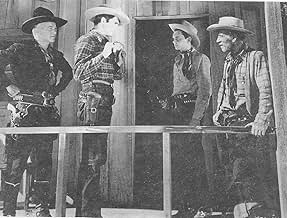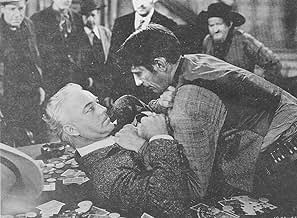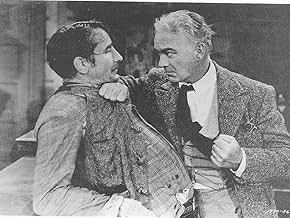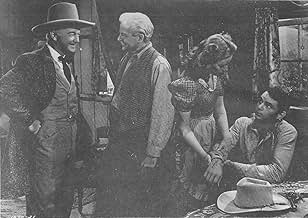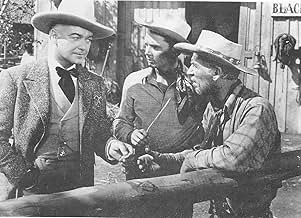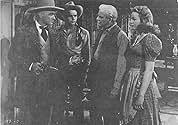अपनी भाषा में प्लॉट जोड़ेंSheriff Hoppy has to find a way to bring the bad guys, headed by Tom Jordan, to justice in the Lone Star state. The problem is that they are hiding out beyond his jurisdiction, in Oklahoma.Sheriff Hoppy has to find a way to bring the bad guys, headed by Tom Jordan, to justice in the Lone Star state. The problem is that they are hiding out beyond his jurisdiction, in Oklahoma.Sheriff Hoppy has to find a way to bring the bad guys, headed by Tom Jordan, to justice in the Lone Star state. The problem is that they are hiding out beyond his jurisdiction, in Oklahoma.
- निर्देशक
- लेखक
- स्टार
Robert Mitchum
- Rigney
- (as Bob Mitchum)
Victor Adamson
- Townsman
- (बिना क्रेडिट के)
Roy Bucko
- Posse Rider
- (बिना क्रेडिट के)
Bob Burns
- Poker Player
- (बिना क्रेडिट के)
Ben Corbett
- Poker Player
- (बिना क्रेडिट के)
Herman Hack
- Henchman
- (बिना क्रेडिट के)
फ़ीचर्ड समीक्षाएं
This traditional "Hoppy" adventure was never meant to be any kind of classic, but mainly functions as Saturday Matinée fare, a pitting of the good guys against the bad guys with plenty of horse chases and gun-play to keep the kids in their seats and wanting to come back for more.
Having grown up in the 1940's, I watch the old Westerns today for reasons other than a gripping plot about which the outcome is clearly foretold. The photography in this one, for example, is exceptional, with cinematographer Russell Harlan going beyond the usual camera set-ups to capture the beauty of location shooting in Lone Pine, California-- the desert-like conditions shot against mountain vistas, the beauty of rustling sycamores framing the action, and exceptional long shots giving us such keen perspectives as robbing of the Well's Fargo Stage from several angles (Harlan, incidentally, went on to film the indelible images of To Kill A Mockingbird). FYI, an unsolicited commercial: Platinum Productions (though Echo Bridge) has released the Cassidy adventures in multiples for very little money, and the transfers are remarkable!
Another incidental pleasure of Hoppy Serves A Writ is Hoppy himself, of course, a cool character who always seems a little above the chaos around him: William Boyd, a leading man from the 1930's found his niche in these Westerns--and we don't have to listen to him sing! Frequently pointed out is Robert Mitchum's first major appearance in a film: a performance at the edge of narcolepsy, but Mitchum actually saddles up a few times and rides; future Superman George Reeves has a meatier role as a dude with attitude, attempting to romance the sole female on the film, but losing her to Hoppy's cute, mild-mannered assistant. And for those with an eye for familiar character actors, the laconic Byron Foulger serves as a shopkeeper; Victor Jory, so often a villain in both Westerns and crime films, sports a nasty scar on his cheek that marks him as the one to hiss.
In all, this is 64 minutes of matinée fun, perfect for a Saturday afternoon with a bowl of popcorn and all your memories of time well spent with your Hollywood pals.
Having grown up in the 1940's, I watch the old Westerns today for reasons other than a gripping plot about which the outcome is clearly foretold. The photography in this one, for example, is exceptional, with cinematographer Russell Harlan going beyond the usual camera set-ups to capture the beauty of location shooting in Lone Pine, California-- the desert-like conditions shot against mountain vistas, the beauty of rustling sycamores framing the action, and exceptional long shots giving us such keen perspectives as robbing of the Well's Fargo Stage from several angles (Harlan, incidentally, went on to film the indelible images of To Kill A Mockingbird). FYI, an unsolicited commercial: Platinum Productions (though Echo Bridge) has released the Cassidy adventures in multiples for very little money, and the transfers are remarkable!
Another incidental pleasure of Hoppy Serves A Writ is Hoppy himself, of course, a cool character who always seems a little above the chaos around him: William Boyd, a leading man from the 1930's found his niche in these Westerns--and we don't have to listen to him sing! Frequently pointed out is Robert Mitchum's first major appearance in a film: a performance at the edge of narcolepsy, but Mitchum actually saddles up a few times and rides; future Superman George Reeves has a meatier role as a dude with attitude, attempting to romance the sole female on the film, but losing her to Hoppy's cute, mild-mannered assistant. And for those with an eye for familiar character actors, the laconic Byron Foulger serves as a shopkeeper; Victor Jory, so often a villain in both Westerns and crime films, sports a nasty scar on his cheek that marks him as the one to hiss.
In all, this is 64 minutes of matinée fun, perfect for a Saturday afternoon with a bowl of popcorn and all your memories of time well spent with your Hollywood pals.
Check out Hoppy in an uptown suit of all things. As a sheriff in Texas he's after stage robbers and cattle rustlers who've escaped into Oklahoma Territory where he's got no authority. So he goes undercover in a suit as a cattle buyer along with his two buddies. But how can he get the baddies back to Texas where he can arrest them.
Solid if unexceptional entry in the series, notable mainly for its unusual supporting cast. This is the iconic Robert Mitchum's first flick. He's one of the baddies and has, by my count, two scenes where he speaks. It's not auspicious, but he's on his way. Then there's George Reeves, another of the baddies, with many more lines. Later he would star in the 1950's series Superman, and die violently in 1959 under highly suspicious circumstances. Lastly is Victor Jory, a superb villian from many 40's crime flicks. Too bad he doesn't have more scenes here to unnerve the audience with.
Anyway, there's lots of hard riding, a big final shootout, and maybe best a heckuva barroom brawl. I guess my only gripe is Clyde's California whose wild antics sometimes go over the top. But that's minor. What's major is that it's good Hoppy entetainment for front-row geezers like me and cowboy fans of all ages. And, oh yeah, before I forget: Catch that adult-level innuendo when Hoppy checks in to the hotel as Jones, to which the clerk responds by saying that a lot of couples check in under that same name! Some writer's sneaky inside joke, I guess.
Solid if unexceptional entry in the series, notable mainly for its unusual supporting cast. This is the iconic Robert Mitchum's first flick. He's one of the baddies and has, by my count, two scenes where he speaks. It's not auspicious, but he's on his way. Then there's George Reeves, another of the baddies, with many more lines. Later he would star in the 1950's series Superman, and die violently in 1959 under highly suspicious circumstances. Lastly is Victor Jory, a superb villian from many 40's crime flicks. Too bad he doesn't have more scenes here to unnerve the audience with.
Anyway, there's lots of hard riding, a big final shootout, and maybe best a heckuva barroom brawl. I guess my only gripe is Clyde's California whose wild antics sometimes go over the top. But that's minor. What's major is that it's good Hoppy entetainment for front-row geezers like me and cowboy fans of all ages. And, oh yeah, before I forget: Catch that adult-level innuendo when Hoppy checks in to the hotel as Jones, to which the clerk responds by saying that a lot of couples check in under that same name! Some writer's sneaky inside joke, I guess.
Everybody mentions Robert Mitchum in this movie, but if you coughed at the right time, you miss his entire dialog. George Reeves had the meatier part and looked Superman-ish in it. Victor Jory was a well known actor who did a lot more than cowboy baddies. Two others stood out for me. One was Earl Hudgins, the barkeep, a solid character actor who had a long list of movie credits, usually as some kind of con artist. The other was Roy Barcroft, a competent heavy in many TV cowboy shows of the 50s. In this, he had a minor part as a rancher with a complaint. There was plenty of action in this Hoppy flick if you count all the endless horse riding and the several long gunfights. The one nothing part was the lone female who gave up acting after this, her first and last job in Hollywood.
I find this an excellent departure from the usual Hoppy routine. The dialog when Hoppy is checking into the hotel is worth the price of admission. Maybe it's just me but I find it side splitting, and a tad more adult than you'd expect from either a Hoppy movie or any movie made in 1943. William Boyd's personality is as winning as ever. Seeing Robert Mitchum's first film appearance is a hoot and George Reeves inclusion is welcome, as always. Both Mitchum and Reeves would be regulars in the Hoppy films for several years, alternating between the bad guy and the good guy. That's all I've got to say on this subject. I have to add some lines to get this to be accepted by IMDb.
Nothing special in this Hoppy movie other than William Boyd's winning personality. He shines in all the Hoppy series. I enjoyed his warm, chuckling condescension to most everyone in the movie -- his enemies, his sidekicks, et. al. One good example is when he arrives incognito as a gentleman gambler at a saloon looking for the bad guys. Hoppy sits in at a poker game, taking the favorite (empty) chair of the main bad guy (Victor Jory). Jory walks over later, angry, and tells Hoppy, "Didn't anyone tell you that is my chair?" Hoppy replies, "Yeah, but I am not particular." That cracked me up.
The plot and the actors were nothing special. It was Robert Mitchum's first film roll, a small part. Nothing was asked of him, and he didn't do anything at all special in the roll, sleepy looking as usual, as though they didn't pay him enough. I did like George Reeves' (TV's Superman) acting.
One neat plot ploy was when Reeves was captured by Hoppy and Co., but refused to tell where in the cabin the money was hidden. But Hoppy kept his eye on Reeves as Hoppy's sidekick moved about the room looking for the money. When he got close, Hoppy knew where the money was based on Reeves' flinching reaction! One laughably silly scene was at the end when Hoppy threw his rope to lasso three retreating bad guys together at the same time! Yes, all three squeezed together inside the loop of the rope!
The plot and the actors were nothing special. It was Robert Mitchum's first film roll, a small part. Nothing was asked of him, and he didn't do anything at all special in the roll, sleepy looking as usual, as though they didn't pay him enough. I did like George Reeves' (TV's Superman) acting.
One neat plot ploy was when Reeves was captured by Hoppy and Co., but refused to tell where in the cabin the money was hidden. But Hoppy kept his eye on Reeves as Hoppy's sidekick moved about the room looking for the money. When he got close, Hoppy knew where the money was based on Reeves' flinching reaction! One laughably silly scene was at the end when Hoppy threw his rope to lasso three retreating bad guys together at the same time! Yes, all three squeezed together inside the loop of the rope!
क्या आपको पता है
- ट्रिवियाThis is one of 54 Hopalong Cassidy features produced by Harry Sherman, initially distributed by Paramount Pictures from 1935-1941, and then by United Artists 1942-1944, which were purchased by their star William Boyd for nationally syndicated television presentation beginning in 1948 and continuing thereafter for many years, as a result of their phenomenal success. Each feature was re-edited to 54 minutes so as to comfortably fit into a 60 minute time slot, with six minutes for commercials. It was not until 50 years later that, with the cooperation of Mrs. Boyd. i.e. Grace Bradley, that they were finally restored to their original length with their original opening and closing credits intact.
- गूफ़When Hopalong Cassidy crosses the river on his horse, the lower half of his body is completely submerged in the water, but when he arrives at the cabin where he meets Jean Hollister (Jan Christy) and Steve Jordan (George Reeves), his clothes are completely dry.
- इसके अलावा अन्य वर्जनThe original 16mm television syndication prints of this film , and others in the "Hopalong Cassidy" theatrical feature film series, were pre-edited to 54 minutes. Television stations could show these prints, with the typical 6 minutes of commercials and promos, in a one hour time slot. The broadcasters would run them as if they were a one hour Hopalog Cassidy television series or mix them in with other western features.
- कनेक्शनFeatured in Forty Thieves (1944)
टॉप पसंद
रेटिंग देने के लिए साइन-इन करें और वैयक्तिकृत सुझावों के लिए वॉचलिस्ट करें
विवरण
- चलने की अवधि1 घंटा 7 मिनट
- रंग
- पक्ष अनुपात
- 1.37 : 1
इस पेज में योगदान दें
किसी बदलाव का सुझाव दें या अनुपलब्ध कॉन्टेंट जोड़ें

